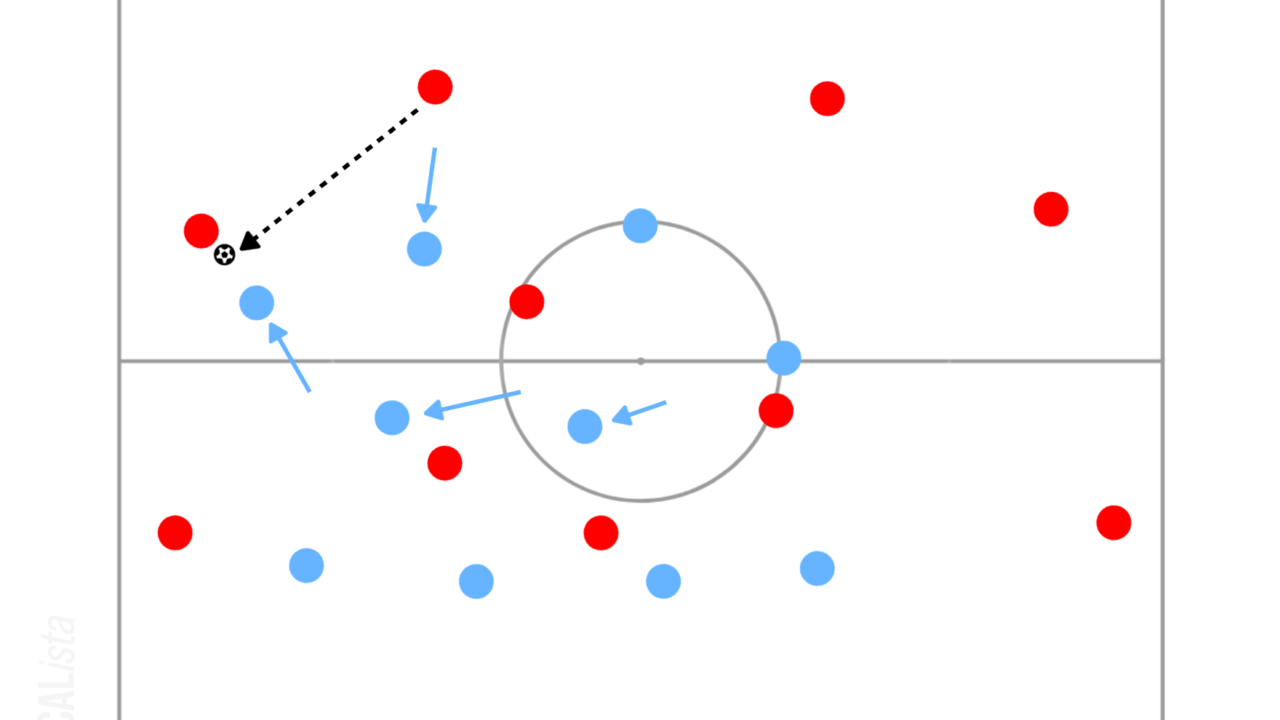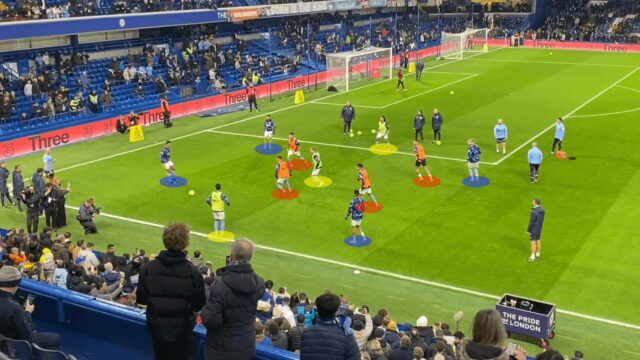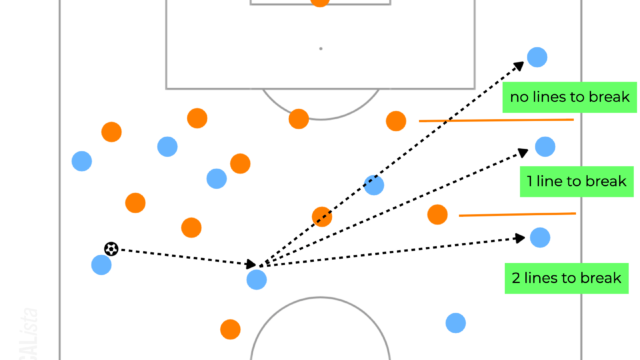What Is Zone Defence? [Football Tactics Explained]

Introduction
“Zone defence” is a term which can mislead us in many ways. In some cases, it means that players defend the specific zone allocated to each player, but it is rare to see defenders stay in specific areas on the pitch. Instead of occupying the area, it is often encouraged to shuffle across to keep the distance each other depending on the position of the ball. This is one of the great examples of prioritising the position of teammates rather than the specific area on the pitch. Moreover, it is also possible to say that the position of the ball has an impact on movements of defenders. In this case, it is obvious that defenders will shift towards the ball side, so if the ball is switched, they will move to the side which the ball was played towards. Additionally, not only the horizontal movements of defenders, but it is also considered as the attribute of zone defence to control the back line vertically on the pitch.
So far, the discussion sounds like zone defence is not about defending specific zones. However, there are situations of defending specific zones on the pitch, especially in the box. This is obviously because the goal is on the middle of the goal line and that can be the reference of deciding where to position. In the midfield of the pitch, all defenders would shuffle across with keeping the distance between defenders, specifically between the fullback and centre back in the ball side. However, in the final third of the own half, the centre backs often decide to stay in front of the goal to defend the most important thing on the pitch, accepting that the distance between the fullback and centre back is stretched. Thus, the pitch geography, or specific zones on the pitch, is still an important element.
So, it is difficult to conclude like ‘zone defence is this!’ because there are so many factors. However, people like to create dichotomies such as possession or counterattacks, positional play or relational play and, of course, man marking and zone defence. Therefore, in this article, some of key factors relating to zone defence will be discussed in detail to find out what zone defence is.
Key Factors
Defending as a Team
If the clear definition of zone defence must be presented in the context of man marking versus zone defence, it would be defending as a team rather than the collection of 11 individual battles on the pitch. All teammates work together, so if someone tries to press, everybody steps up or if the objective as a team is doing so at the moment, you cannot be lazy.
Additionally, the compactness is often used to evaluate the quality of defending as a team. A compact block which teammates keep the appropriate distance between each other makes it possible to narrow the space for the opponents to invade, cover each other even though being dribbled past or secure second balls.
However, there is a situation which the team cannot keep the compactness, high pressing. Due to the offside rule, the back line hardly progresses beyond the halfway line, but if a striker applies pressure on the opposition goalkeeper, the distance between the back line and the striker is stretched. Therefore, it is difficult for the team to keep the compactness during high pressing. In other words, if you want to press high, it is important to have an ability to switch man marking and zone defence depending on the situation. For example, the flow of pressing high would be like initially keeping the compactness to prevent them from playing through or secure second balls if they play over, but when the ball is played back or to targeted opponent, the players step up to mark the opponents especially around the ball to win it. The detail will not be discussed here because the main focus of this article is zone defence, but I am going to write about these tactics of pressing, so pleas wait little bit.
Defending as a Line
It was discussed how important it is to work as a team to defend zonally. So, the detail of groups or individuals are going to be analysed deeper. A whole defensive organisation of a team can be considered as a collection of lines. Usually, there are three lines such as a 4-4-2 or 5-3-2. However, if a system is a 4-5-1 or 5-4-1, can the striker be considered as a line? Moreover, if my memory is right, Russia had used a 5-5 against Spain in the World Cup in 2018. So, the number of lines is mainly three or two. Additionally, in terms of how to treat the striker, it is possible to say that there is no horizontal function for the forward line, but the compactness between the striker and the midfield line is crucial, as it was discussed in the previous chapter.
The objective of each line, especially the midfield and defensive line, is to prevent the opposition team from breaking the line. It sounds simple, but the balance is difficult. If the distance between each player on a line is narrow, it is possible to defend the middle, but it becomes easier for the opposition team to play around to break the line. On the other hand, if the line is stretched, obviously they can play through. In order to overcome this annoyance, some hard works are required and how to do it will be discussed later.
Cover Shadow
Preventing them from breaking a line sounds like a passive objective. However, this does not mean just keeping the line close and deep, though this can happen in the final third of the own half to just defend a lead in the added time. Additionally, not applying any pressure on the ball is also, or maybe more, dangerous than stepping up to press on the ball because the opposition player on the ball can carry the ball or play it forward comfortably. Therefore, a player needs to step up to press on the ball with accepting to leave the line, although how to cover it will be discussed later.
One of the famous terms to describe how to press on the ball, which is seen on Google or Twitter, is ‘cover shadow’. You can google it and find some definitions of it, but anyway, it means that a player moves to apply pressure on the ball with cutting a passing lane. This is extremely important in two ways. Firstly, by cutting a passing lane to break the line, it is possible to apply pressure on the ball without accepting a risk of being played through. Additionally, by cutting a passing lane to play inside, it is possible to force the opposition player on the ball to play wide, which is one of the (controversial) basics of defending. However, recently it became common that the winger cuts the passing lane from the centre back on the ball to the ball side fullback, or from outside to inside. This looks opposite to that principle, but it works well. Let me talk about this, although this is not the main topic here, so you can skip it to the next chapter.
Firstly, forcing the opposition to play outside is still an important principle. This is because it is possible to use the touch line as a defender and lock the opposition in. However, after sandwiching them with the touch line, the ball is most likely to go out, resulting in a throw in. On the other hand, if forcing them to keep play in the middle where the midfielders are keen to intercept a split pass, it is possible to play a counterattack as soon as winning the ball.
Secondly, the pressing from the inside to outside was effective especially against right-footed left centre backs. If the opposite-footed centre backs control the ball by a front foot, which makes it difficult to play the fullback, the centre back on the ball was killed.

However, if both centre backs can play with their back foot, they can play away from the pressure and easily play through.

Then, this is another reason why the pressing from the outside to inside is effective. Most of all centre backs would control the ball by their back foot and open their body, creating the passing lane to the fullback. However, the winger is pressing to the centre back on the ball from the outside to inside, cutting the passing lane to the fullback. Or, if the centre back failed to recognise the outside before receiving the ball, the winger will come from the blind side and the centre back would be panic.

When the winger is pressing, the striker can stay in the middle with marking the opposition defensive midfielder. Thus, only the option is playing through, but it is predictable for the defensive midfielder to intercept. Those are the main reasons why forcing them to play wide is not enough in some situations.
Even though the cover shadow sounds simple, but this is difficult and fragile. When the player stepping up to apply pressure on the ball, the opposition player to receive a split pass is in the blind side. Therefore, by moving little bit in the blind side, the passing lane can be recreated. Additionally, the opposition player on the ball can also recreate the passing lane by moving the ball or stepping in slightly. Thus, it is hard to rely on the cover shadow so much. So, how to support the cover shadow is important to prevent them from breaking the line, and it is the concept of ‘press & cover’.
Press & Cover
If one of the teammates on the same line steps up to press, other players on the line needs to cover by being narrower to close the gap between each player. The objective is, as it has been emphasised, preventing the opposition team from playing through.
However, too many repeats of covering make it nearly impossible to win the ball. This is because if the opposition player plays a horizontal pass, the player who initially made a movement of covering will step up to apply pressure on the ball. This is a good movement in term of press & cover, which the objective is just preventing from being played through and not winning the ball. However, the distance between the opposition player on the ball and the next player to step up is far, so the pressure is less intense.

(The left winger presses & the left striker or other MFs cover)

(However, the left striker needs to press after covering, so the pressure is not intense, and the opposition centre back can play the ball comfortably)
The result of repeating just press & cover would be being played around or over, or hopefully winning the ball thanks to the opposition mistake, which is passive. To be fair, it is possible to overcome this structural weakness by intensity or hard works, which is pressing quicker to force the opposition player on the ball. However, it is not the benefit of zone defence, but players’ physical superiority rather than tactical support. Therefore, especially when the ball is played to the wide area, many teams turn zone defence into man marking.

So far, it can be concluded that press & cover makes it possible to prevent them from playing through and using the space in the middle. Then, the next discussion will be how to gain the advantage when the ball is played wide.
Shuffling
Shuffling across was already discussed and considered as one of the typical movements of zone defence. As the key principle of zone defence is defending as a team, when the ball is played to the right side, all players move towards the right side. This enables to have an overload in the ball side. As it was discussed that when the ball is played to the outside, the players around the ball often try to mark the opposition players around the ball tightly to win the ball rather than press & cover. Even though it is man marking around the ball, however, thanks to the opposite side player shuffling across, it is possible to make it an overloaded situation around the ball. This means that after the player pressing on the ball is beaten, it is not over. If the opposite side players do not shuffle across the pitch, it is over.
Therefore, it is possible to say that the quality of shuffling across determines the quality of zone defence. More precisely, of course it does not apply to all situations though, it is possible to measure the quality of zone defence by observing the opposite side winger or wide midfielder. It is often seen that the opposite side winger drops back to mark the opposition winger. This is not the attitude of zone defence, but it is a man oriented defensive movement.

Based on zone defence, the position of teammates is more prioritised than the position of the opponents. Therefore, in this case, the furthest opponent should be ignored, although of course the presence should be recognised. For this reason, it is possible to measure the quality of zone defence by observing the position of the opposite side winger.
Line Control
Not only horizontal compactness, but also vertical compactness is vital. It was ‘shuffling’ to maintain the narrowness the shape, but to remain vertically compact, ‘line control’ is massively important.
Firstly, to keep the shape compact, the lines should be adjusted depending on the situation of the ball. If the ball is played back, the lines should be pushed up. Otherwise, the team will be forced to drop back forever and fixated in the own half. It is okay if there is a lead in the added time, but usually it is not a clever way. On the other hand, if the team constantly find a timing to push the lines up, it is possible to progress the team without having the ball. However, pushing the lines up is not the only way of controlling the lines and it is also vital to know when to drop back. The lines should be stopped before the ball is about to be kicked long and as soon as the opposition player on the ball tries to play in behind, the lines should start to drop back. Otherwise, one of the opposition attackers will receive the ball in behind easily and have a chance of easy 1v1 against the goalkeeper. Therefore, it is important to be trained well to push the lines up and drop back together.
Secondly, when talking about ‘line control’, it is often about the back line and offside trap. However, it is not only for the defensive line to control but also all two or three lines need to be controlled at the same time. For example, when the back line was pushed up, if the attackers did not step up, the ball would be conformably played in behind without any pressure. Additionally, when the back line was not pushed up well, if one of the attackers sprints and applies pressure on the ball, the whole shape is stretched, so it becomes easy to play through. Of course, it is same when dropping back. All lines need to be controlled at the same time, not the job for only the centre backs.
Defending the Goal
As it was mentioned in the introduction, basically zone defence is not the way of managing the specific zones, except for defending the own box and goal. This is because the goal is only in the middle. As a result, especially centre backs often stay in front of the goal when the ball is played wide, in contrast to the concept of shuffling.
The problem here would be the distance in the channels, the space between the centre back and fullback. After the ball is played wide and the centre backs decided to stay in front of the goal, the full back would be isolated. If the fullback press on the ball, there is a huge space for the opponents to exploit while if the fullback tries to close the gap, the ball is crossed comfortably. Then, what is the best solution? Please forgive me but I will write about this later because it is worth being concluded in an exclusive article. It will be my next tactical analysis article.
Conclusion
In conclusion, it was discussed what key factors are to defend zonally. Those seven factors may not be everything, but it is important to know them to identify how well the team is defending zonally. Probably, zone defence is one of the basics in football, so most of all teams defend zonally especially in the midfield or own half. However, recently some teams press high with man marking or mark key players in the midfield. I believe it is only possible to understand why they selected man marking by knowing what zone defence is. I hope this article helps you to understand zone defence in football. Thanks for reading.


